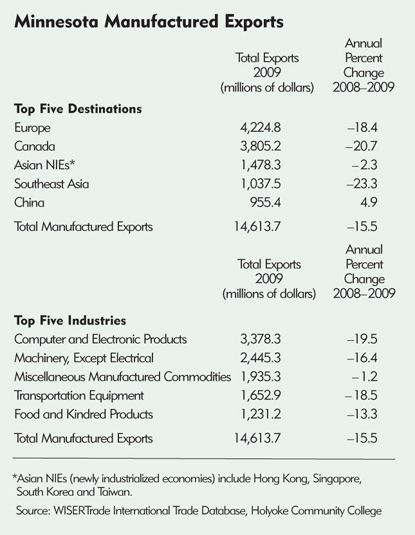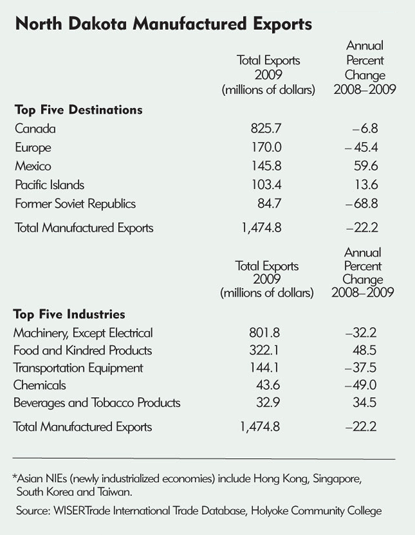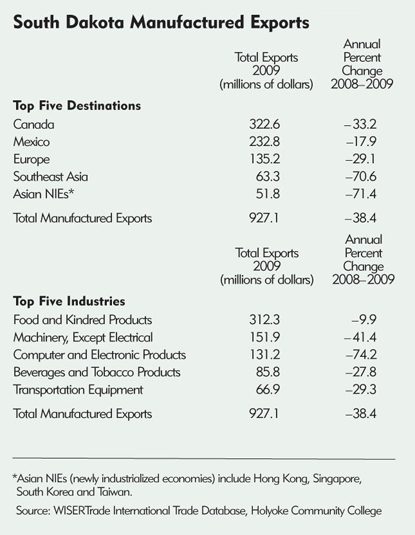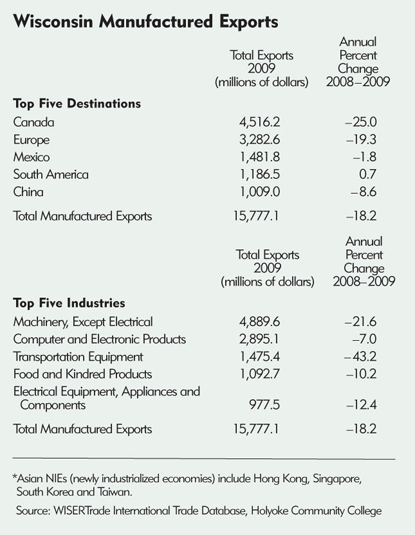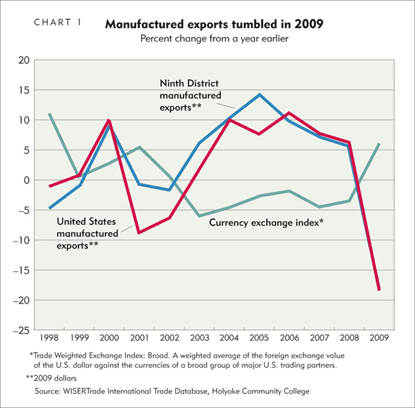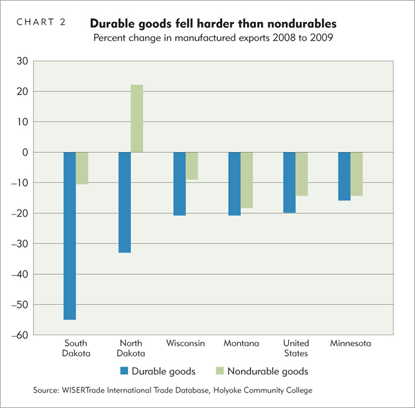A global recession and small appreciation of the U.S. dollar led to the largest annual decrease in exports at both the district and the national level since export data first became available in 1997.
Last year, district and U.S. manufactured exports dropped 18 percent to $33.7 billion and $916.7 billion, respectively (see Chart 1). The bloodletting was widespread, affecting virtually all export destinations and product sectors.
For example, all district states saw decreases in exports to Canada and Europe, the district’s largest export destinations, which account for over half of all manufactured exports. While GDP growth was still positive during 2009 in some developing countries, including China and India, district exports decreased to almost all of these destinations as well.
There were a few bright spots. Minnesota exports to China rose by 5 percent, and North Dakota saw a 60 percent increase in exports to Mexico, primarily from shipments of food and kindred products. Exports to South America also increased slightly from Wisconsin due to relatively hefty increases in machinery sent to Chile and Peru.
However, steep declines were more the rule. Exports to Canada decreased by 20 percent or more from all district states, except North Dakota, where exports dropped by a more modest 7 percent. Exports to Europe were down across the board, but off the most from North Dakota, at 45 percent. South Dakota, which had the steepest overall export decline of 38 percent, posted a combined decrease of more than 70 percent to Hong Kong, Singapore, South Korea and Taiwan.
U.S. dollar stronger in 2009
The average value of the U.S. dollar relative to the Canadian dollar and the euro increased by 7 percent and 6 percent, respectively, during 2009 compared with the previous year, which increased the cost of district exports abroad. A broader measure of the value of the U.S. dollar relative to the currencies of 26 major trading partners increased 6 percent (see Chart 1).
In contrast, the value of the U.S. dollar relative to the Japanese yen decreased by 9 percent during 2009, making district goods relatively less expensive in Japan and a likely reason that district exports there saw a smaller overall decrease (6 percent).
A silver lining in the data is that while the level of manufactured exports was down substantially last year, quarterly data show gradual improvement over the course of the year. By the fourth quarter 2009, exports were down only 9 percent from a year earlier, compared with a decline of more than 20 percent for the first three quarters. If modest improvement continues through this year, 2010 will likely pull ahead of 2009’s dismal performance. However, it may take longer to top 2008’s level of $41.1 billion in total exports.
Durable goods lead decline in export products
Exports of durable manufactured goods (products with a useful life of more than three years) make up the three largest export categories in the district: machinery, computer and electronic products, and transportation equipment. Their steep declines were a central factor in the overall drop in manufactured exports as global demand for durable goods fell sharply during the recession (see Chart 2). Nondurable goods tended to decrease at a more modest pace, such as the district’s fourth-largest export industry, food and kindred products, which decreased by 8 percent.
Trends by particular industry include a drop in transportation equipment by more than 40 percent from Wisconsin and Montana and a decrease in chemicals by 49 percent from North Dakota. Steep declines were also noted in South Dakota, where machinery decreased 41 percent and computer and electronic products decreased 74 percent. Exceptions include a 6 percent increase in exports of primary metal products from Montana, which were largely sent to Japan. Meanwhile, exports of food and kindred products were up 49 percent from North Dakota.
Exports to Iraq and Afghanistan increase
The presence of U.S. military operations coincided with increases in district manufactured exports to Iraq and Afghanistan from practically zero early in the decade to over $20 million to each country in 2009. Nevertheless, these levels represent only a tiny fraction of total district exports.
Iraq received $24 million in district exports in 2009, an 8 percent increase from a year earlier. About 85 percent of the exports included machinery and transportation equipment.
Exports to Afghanistan increased 73 percent in 2009 to $20 million. Over half of these exports were transportation equipment, with machinery, food and kindred products, and electrical equipment, appliances, and components making up most of the remainder.
